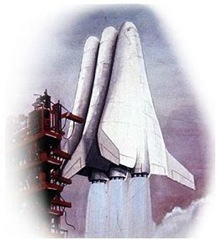If you thought that Britain had contributed little to the space race or the exploration of outer space, think again because long before anyone across the Atlantic had dreamed up the Enterprise, Columbia or Challenger Space Shuttles, the British Aircraft Corporation (BAC) had come up with detailed plans for something very similar: The Multi-Unit Space Transport And 
Apparently, the idea for MUSTARD came from the Air Ministry which gave a contract to BAC to study hypersonic speed with a team being formed under Smith’s leadership at BAC’s Warton airbase, near Preston, Lancashire. That team began to look at ideas he described in a latter interview that were “Concorde-ish in nature” with the design for MUSTARD being completed in 1964 and 1965.
The MUSTARD design concept called for a three-stage reusable aircraft launched as a single unit with two of the units acting as boosters to launch the third into space before separating and returning to earth as normal aircraft. Likewise and after any payload was sent into orbit, the third unit would also return to earth in the same manner.
At the time, it was hoped that the work could lead to a recoverable multi-stage aerospace vehicle that would have Europe in outer space within 10 to 15 years at a cost that was 20 to 30 times cheaper than the rocket technology being used at the time. However, the idea was way ahead of its time and as with many innovative British ideas at the time, there was no political will to move it forward. Hence, outer space was largely left to the Americans and the Soviets while it was the Americans who became interested in the idea of a reusable aircraft that ultimately became the Space Shuttle.
If you want to learn more about Britain’s contribution to the race to explore outer space, there is a great website at http://www.britain-in-space.co.uk which goes into considerably more detail about those efforts.